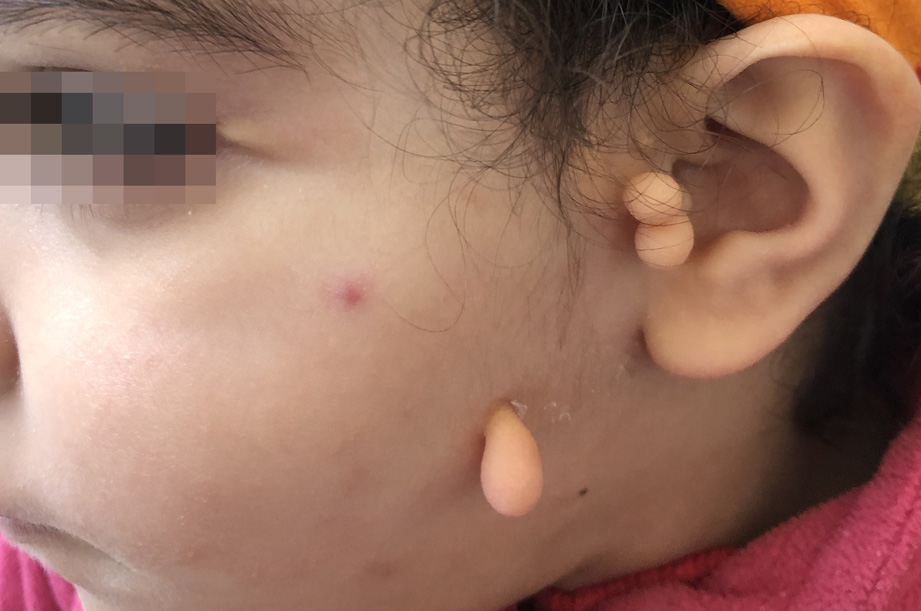Goldenhar syndrome. A new case.

Downloads
DOI:
https://doi.org/10.26326/2281-9649.31.4.2290How to Cite
Abstract
Goldenhar syndrome (GS) or oculo-auriculo-vertebral dysplasia (4) is a diverse and poorly understood disorder that is usually apparent at birth.
The incidence of Goldenhar syndrome has been reported to be varying from 1:3500 to 1:5600 live births and it is present in 1:1000 children with congenital deafness with a male to female ratio of 3:2 (9). Its origin is due to the abnormal development of vascularization in 4th week of pregnancy when it comes to the development of the 1st and 2nd pharyngeal arches responsible for growth of craniofacial structures (2). There is not enough information to identify its etiologic factors. Some cases appear to be genetic, while others occurring in a sporadic manner (2) are probably due to environmental factors. Abnormalities of chromosomes have been identified (10). The ingestion of some drugs such as cocaine, thalidomide, retinoic acid, and tamoxifen by the mother during pregnancy were also related to the development of the disease (6), so as maternal diabetes (1). It was not possible to determine the etiology in our case since the mother and other close relatives were not available for interrogation.
The spectrum of GS abnormalities ranges from mild forms to severe ones and include patients with barely noticeable facial asymmetry to very pronounced facial defects with more or less severe abnormalities of internal organs and/or skeleton. GS can involve ocular anomalies, including microphthalmia, anophthalmia, epibulbar dermoid (or lipodermoid) tumors, eyelid colobomas, and hypertelorism, aural defects, such as preauricular tags, anotia, microtia, and hearing loss, and vertebral abnormalities, such as scoliosis, hemivertebrae, and missing ribs (8). The patient can exhibit also dentofacial abnormalities with unilateral facial hypoplasia, due to hypoplasia of the zygomatic, maxillary and mandibular area, and prominent forehead. There may be an association with other major organ system anomalies including cardiac structural defects, renal agenesis, pulmonary agenesis, and vascular anomalies.
Despite the reported frequency of cardiovascular alterations (tetralogy of Fallot and transposition of the great vessels) ranging from 5 to 58% (7), in our patient no cardiovascular alterations were found. Renal problems commonly associated to malformations of the ears were not diagnosed. Central nervous system anomalies such as hydrocephalus, meningoencephalocoele and mental retardation (5) have been associated with the syndrome; however, our patient did not exhibit any of those defects. However, as far as we know, this is the first case described presenting breast hypertrophy with retraction of the nipple.
With all these anomalies, no agreeable clinical diagnostic criteria have been reported in the literature. There are no specific genetic tests. The presence of auricular abnormalities, mandibular hypoplasia, and spinal abnormalities can be put together to consider it as a case of OAV spectrum.
Feingold and Baum offered for the delineation of Goldenhar syndrome working criteria that included a lipodermoid or lipoma of the conjuctiva, an epibulbar dermoid or an upper lid coloboma and two of the following three criteria: small size or abnormal shape of the ears or preauricular skin tags or both, unilateral aplasia or hypoplasia of the ramus of the mandible and vertebral anomalies (3). In our case, the diagnosis was established according to these criteria.
Treatment of patients with GS is complex and should be divided into stages, according to patient’s age, as well as the extent and severity of observed abnormalities. In some mild cases, no treatment is needed. In uncomplicated cases, cosmetic damage is a basic concern. Otherwise, correction of all malformations requires long-lasting, multistage and complex treatment plan. Cleft repair, corrections of colobomas, ear anomalies at the age of 6 to 8 years and removal of dermoids and preauricular tags at the age of 5 are principal reconstructions. The complex treatment is focused not only on physical care, but also on the prevention and treatment of the psychosocial aspects of the malformation.
